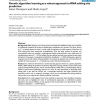Free Online Productivity Tools
i2Speak
i2Symbol
i2OCR
iTex2Img
iWeb2Print
iWeb2Shot
i2Type
iPdf2Split
iPdf2Merge
i2Bopomofo
i2Arabic
i2Style
i2Image
i2PDF
iLatex2Rtf
Sci2ools
BMCBI
2006
2006
Genetic algorithm learning as a robust approach to RNA editing site prediction
Background: RNA editing is one of several post-transcriptional modifications that may contribute to organismal complexity in the face of limited gene complement in a genome. One form, known as C U editing, appears to exist in a wide range of organisms, but most instances of this form of RNA editing have been discovered serendipitously. With the large amount of genomic and transcriptomic data now available, a computational analysis could provide a more rapid means of identifying novel sites of C U RNA editing. Previous efforts have had some success but also some limitations. We present a computational method for identifying C U RNA editing sites in genomic sequences that is both robust and generalizable. We evaluate its potential use on the best data set available for these purposes: C U editing sites in plant mitochondrial genomes. Results: Our method is derived from a machine learning approach known as a genetic algorithm. REGAL (RNA Editing site prediction by Genetic Algorithm L...
Related Content
| Added | 10 Dec 2010 |
| Updated | 10 Dec 2010 |
| Type | Journal |
| Year | 2006 |
| Where | BMCBI |
| Authors | James Thompson, Shuba Gopal |
Comments (0)

